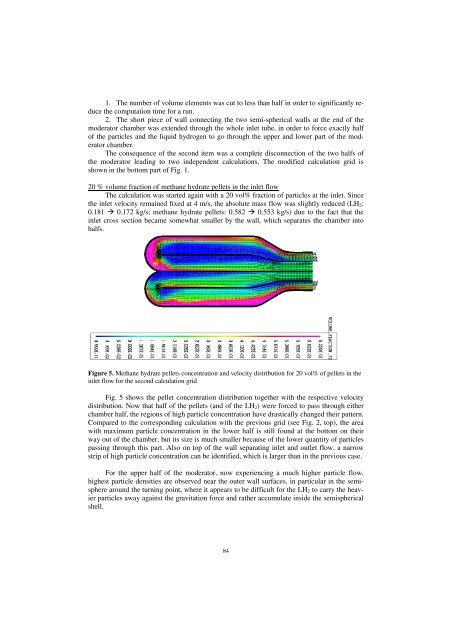Druck-Materie 20b.qxd - JUWEL - Forschungszentrum Jülich
Druck-Materie 20b.qxd - JUWEL - Forschungszentrum Jülich
Druck-Materie 20b.qxd - JUWEL - Forschungszentrum Jülich
Create successful ePaper yourself
Turn your PDF publications into a flip-book with our unique Google optimized e-Paper software.
1. The number of volume elements was cut to less than half in order to significantly reduce<br />
the computation time for a run.<br />
2. The short piece of wall connecting the two semi-spherical walls at the end of the<br />
moderator chamber was extended through the whole inlet tube, in order to force exactly half<br />
of the particles and the liquid hydrogen to go through the upper and lower part of the moderator<br />
chamber.<br />
The consequence of the second item was a complete disconnection of the two halfs of<br />
the moderator leading to two independent calculations. The modified calculation grid is<br />
shown in the bottom part of Fig. 1.<br />
20 % volume fraction of methane hydrate pellets in the inlet flow<br />
The calculation was started again with a 20 vol% fraction of particles at the inlet. Since<br />
the inlet velocity remained fixed at 4 m/s, the absolute mass flow was slightly reduced (LH2:<br />
0.181 � 0.172 kg/s; methane hydrate pellets: 0.582 � 0.553 kg/s) due to the fact that the<br />
inlet cross section became somewhat smaller by the wall, which separates the chamber into<br />
halfs.<br />
Figure 5. Methane hydrate pellets concentration and velocity distribution for 20 vol% of pellets in the<br />
inlet flow for the second calculation grid<br />
Fig. 5 shows the pellet concentration distribution together with the respective velocity<br />
distribution. Now that half of the pellets (and of the LH2) were forced to pass through either<br />
chamber half, the regions of high particle concentration have drastically changed their pattern.<br />
Compared to the corresponding calculation with the previous grid (see Fig. 2, top), the area<br />
with maximum particle concentration in the lower half is still found at the bottom on their<br />
way out of the chamber, but its size is much smaller because of the lower quantity of particles<br />
passing through this part. Also on top of the wall separating inlet and outlet flow, a narrow<br />
strip of high particle concentration can be identified, which is larger than in the previous case.<br />
For the upper half of the moderator, now experiencing a much higher particle flow,<br />
highest particle densities are observed near the outer wall surfaces, in particular in the semisphere<br />
around the turning point, where it appears to be difficult for the LH2 to carry the heavier<br />
particles away against the gravitation force and rather accumulate inside the semispherical<br />
shell.<br />
84

















